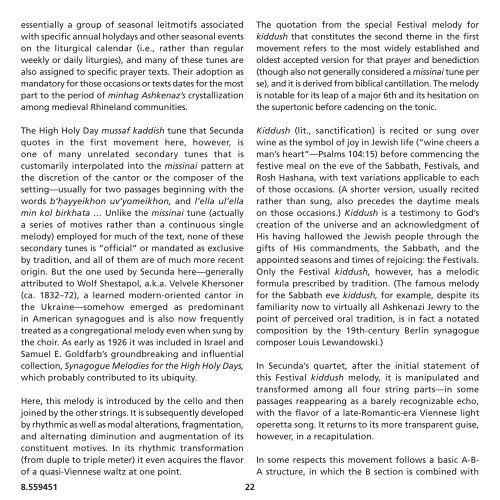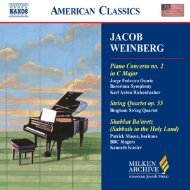Download Liner Notes PDF - Milken Archive of Jewish Music
Download Liner Notes PDF - Milken Archive of Jewish Music
Download Liner Notes PDF - Milken Archive of Jewish Music
You also want an ePaper? Increase the reach of your titles
YUMPU automatically turns print PDFs into web optimized ePapers that Google loves.
essentially a group <strong>of</strong> seasonal leitmotifs associated<br />
with specific annual holydays and other seasonal events<br />
on the liturgical calendar (i.e., rather than regular<br />
weekly or daily liturgies), and many <strong>of</strong> these tunes are<br />
also assigned to specific prayer texts. Their adoption as<br />
mandatory for those occasions or texts dates for the most<br />
part to the period <strong>of</strong> minhag Ashkenaz’s crystallization<br />
among medieval Rhineland communities.<br />
The quotation from the special Festival melody for<br />
kiddush that constitutes the second theme in the first<br />
movement refers to the most widely established and<br />
oldest accepted version for that prayer and benediction<br />
(though also not generally considered a missinai tune per<br />
se), and it is derived from biblical cantillation. The melody<br />
is notable for its leap <strong>of</strong> a major 6th and its hesitation on<br />
the supertonic before cadencing on the tonic.<br />
The High Holy Day mussaf kaddish tune that Secunda<br />
quotes in the first movement here, however, is<br />
one <strong>of</strong> many unrelated secondary tunes that is<br />
customarily interpolated into the missinai pattern at<br />
the discretion <strong>of</strong> the cantor or the composer <strong>of</strong> the<br />
setting—usually for two passages beginning with the<br />
words b’hayyeikhon uv’yomeikhon, and l’ella ul’ella<br />
min kol birkhata … Unlike the missinai tune (actually<br />
a series <strong>of</strong> motives rather than a continuous single<br />
melody) employed for much <strong>of</strong> the text, none <strong>of</strong> these<br />
secondary tunes is “<strong>of</strong>ficial” or mandated as exclusive<br />
by tradition, and all <strong>of</strong> them are <strong>of</strong> much more recent<br />
origin. But the one used by Secunda here—generally<br />
attributed to Wolf Shestapol, a.k.a. Velvele Khersoner<br />
(ca. 1832–72), a learned modern-oriented cantor in<br />
the Ukraine—somehow emerged as predominant<br />
in American synagogues and is also now frequently<br />
treated as a congregational melody even when sung by<br />
the choir. As early as 1926 it was included in Israel and<br />
Samuel E. Goldfarb’s groundbreaking and influential<br />
collection, Synagogue Melodies for the High Holy Days,<br />
which probably contributed to its ubiquity.<br />
Here, this melody is introduced by the cello and then<br />
joined by the other strings. It is subsequently developed<br />
by rhythmic as well as modal alterations, fragmentation,<br />
and alternating diminution and augmentation <strong>of</strong> its<br />
constituent motives. In its rhythmic transformation<br />
(from duple to triple meter) it even acquires the flavor<br />
<strong>of</strong> a quasi-Viennese waltz at one point.<br />
8.559451 22<br />
Kiddush (lit., sanctification) is recited or sung over<br />
wine as the symbol <strong>of</strong> joy in <strong>Jewish</strong> life (“wine cheers a<br />
man’s heart”—Psalms 104:15) before commencing the<br />
festive meal on the eve <strong>of</strong> the Sabbath, Festivals, and<br />
Rosh Hashana, with text variations applicable to each<br />
<strong>of</strong> those occasions. (A shorter version, usually recited<br />
rather than sung, also precedes the daytime meals<br />
on those occasions.) Kiddush is a testimony to God’s<br />
creation <strong>of</strong> the universe and an acknowledgment <strong>of</strong><br />
His having hallowed the <strong>Jewish</strong> people through the<br />
gifts <strong>of</strong> His commandments, the Sabbath, and the<br />
appointed seasons and times <strong>of</strong> rejoicing: the Festivals.<br />
Only the Festival kiddush, however, has a melodic<br />
formula prescribed by tradition. (The famous melody<br />
for the Sabbath eve kiddush, for example, despite its<br />
familiarity now to virtually all Ashkenazi Jewry to the<br />
point <strong>of</strong> perceived oral tradition, is in fact a notated<br />
composition by the 19th-century Berlin synagogue<br />
composer Louis Lewandowski.)<br />
In Secunda’s quartet, after the initial statement <strong>of</strong><br />
this Festival kiddush melody, it is manipulated and<br />
transformed among all four string parts—in some<br />
passages reappearing as a barely recognizable echo,<br />
with the flavor <strong>of</strong> a late-Romantic-era Viennese light<br />
operetta song. It returns to its more transparent guise,<br />
however, in a recapitulation.<br />
In some respects this movement follows a basic A-B-<br />
A structure, in which the B section is combined with
















